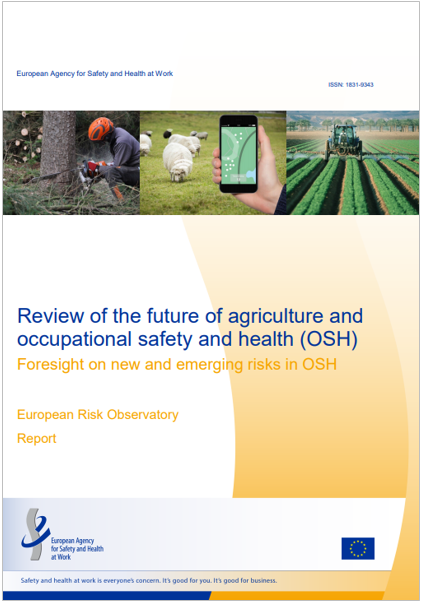
EU-OSHA | Review of the future of agriculture and OSH
Foresight on new and emerging risks in OSH
Agriculture and forestry are among the most dangerous professions in Europe, with a high level of accidents affecting the sustainability and viability of the sector. Over the last 10 years, there has been an average of over 500 registered deaths per year in the agriculture and forestry sector and over 150,000 non-fatal accidents (Eurostat, 2017). Recent research indicates that there is significant under-reporting of both fatal and non-fatal accidents in the agriculture and forestry sector throughout Europe (Merisalu et al., 2019). In many instances, national reporting also places agriculture and forestry top or almost top among sectors in terms of the level of risk.
Farmer health is a key issue in the sector. Coronavirus disease 2019 (COVID-19) and the related OSH risks highlight the importance of health and working conditions in the sector with the European Commission establishing guidelines to protect seasonal workers, including their safety and health (EC, C2020 4813 final) and some Member States establishing guidelines for the agricultural sector (OSH wiki 2020 on COVID-19). Over 60 % of agricultural workers report having a limiting chronic disease and high levels of cardiovascular disease (CVD). According to an EU survey from 2012, workers from the agriculture sector were more likely than those in any other sector to report that their work affected their health (Eurofound, 2012). Eurostat (2010) also reported that work-related health problems occur more often in the ‘agriculture, hunting and forestry’ sector along with in the mining and quarrying sector than in any other sector. This is related to the fact that some of the least favourable job characteristics, such as manual work and atypical working hours, are more prevalent in these sectors. This report summarises a number of OSH risks that affect farmers and foresters. Pesticide-related risks, musculoskeletal disorders (MSDs), zoonoses, skin cancer, and stress and psychosocial issues are all major emerging and continuing risks in the sector that either have not been adequately managed or have been underestimated owing to lack of accurate data over the years.
This report reviews the future trends in agriculture and forestry, such as new technologies and climate change, identifies the resulting technological and organisational changes in the sector and defines the implications for OSH among farmers, foresters and other workers in this sector. The report looks at a number of potential emerging risks, particularly those that are the most imminent, namely those linked to digital evolution in the sector and resulting from climate change. The review aims to support policymakers at European and national levels in their development of strategies, regulations, and enforcement, guidance and support measures.
The report examines a number of issues affecting the future of farming and forestry: smart farming (precision farming, digitalisation, etc.) and other technology developments; climate change and environmental issues; society and consumer trends; the labour market and organisational issues; and international trade and economic considerations.
Smart farming (digitalisation and the use of new technologies) has been the subject of much attention in the sector, being identified as one of the few innovations that could potentially bring about a paradigm shift in productivity and increase food production.
_________
Table of Contents
List of figures
Executive summary
A sector with serious occupational safety and health challenges
A sector in transition
Resulting changes and occupational safety and health outcomes
1 Introduction
2 Methodology
3 Scope of the report
4 The occupational safety and health situation in farming and forestry
5 Overview of occupational health issues
Section A. Identification of major future trends and changes in agriculture and forestry
6 Main trends affecting agriculture and forestry
6.1 Technological innovation through science and technology
6.2 Climate change and the environment
6.3 Food and energy demand (food security)
6.4 Trade and economy
6.5 Policy and people
Section B. Implications for the occupational safety and health of farmers, foresters and other workers
7 Health and safety implications of technological innovation through science and technology
7.1 Smart farming, smart forestry and OSH — general considerations
7.2 Smart farming and OSH improvements
7.3 OSH challenges from smart farming technologies
7.4 OSH challenges from traditional and emerging machinery use
8 Climate change and the environment — occupational safety and health
8.1 Extreme weather events and fires
8.2 Heat exposure
8.3 Exposure to solar ultraviolet radiation
8.4 Animal and insect-borne disease and invasion of predatory species
8.5 Exposure to dust and pesticides
8.6 Specific forestry related risks from climate change
8.7 Impact of climate change on mental health
9 Trade and Economy – Occupational safety and health considerations
9.1 Trade and OSH impacts
9.2 Farm economic trends and their impact on safety and health
10 Labour market trends and impacts on occupational safety and health
10.1 Temporary and/or seasonal workers
10.2 Migrant workers
10.3 Part-time nature of farming and forestry work, linked to a high degree of pluriactivity
10.4 Self-employed farmers
10.5 Farming is very much a family concern
10.6 Role of women in farming
10.7 Retirees and farmers over 65
10.8 Young workers
10.9 Long working hours and OSH impacts in the sector
10.10 Rural depopulation and OSH risks
10.11 Stress and psychosocial risks
Section C. Next steps and future actions
11 Conclusions
12 Recommendations for policy-makers
12.1 OSH policy level
12.2 EU health policy
12.3 EU research into safety and health in agriculture and forestry
12.4 EU agricultural policy - ensuring the social sustainability of farming
References
APPENDICES
Annex 1: Keywords used to identify technological and organisational changes and OSH concepts in agriculture and forestry
Annex 2: Key OSH prevention resources in agriculture
Annex 3: List of experts consulted on the major trends and changes in agriculture
Annex 4: List of experts participating in the expert meeting on OSH in agriculture and forestry
Annex 5: Glossary
List of figures
Figure 1: The top eight killers in agriculture
Figure 2: Mechanised spraying operation
Figure 3: MSDs are prevalent in agriculture
Figure 4: Exposure to noise leads to hearing loss
...
Fonte: EU OSHA
Collegati
Allegati
|
Descrizione |
Lingua |
Dimensioni |
Downloads |
 |
Abbonati Sicurezza Lavoro
|
EN |
5360 kB |
7 |


































